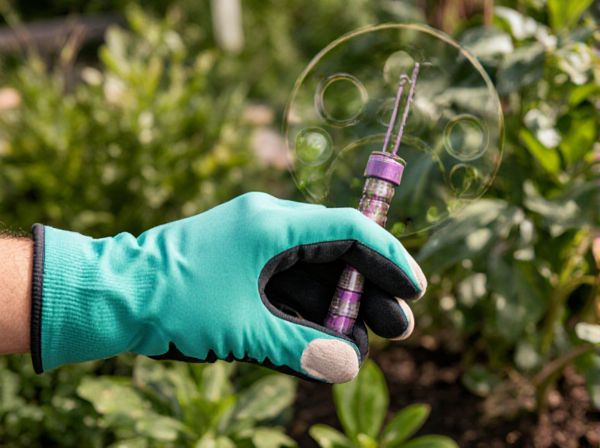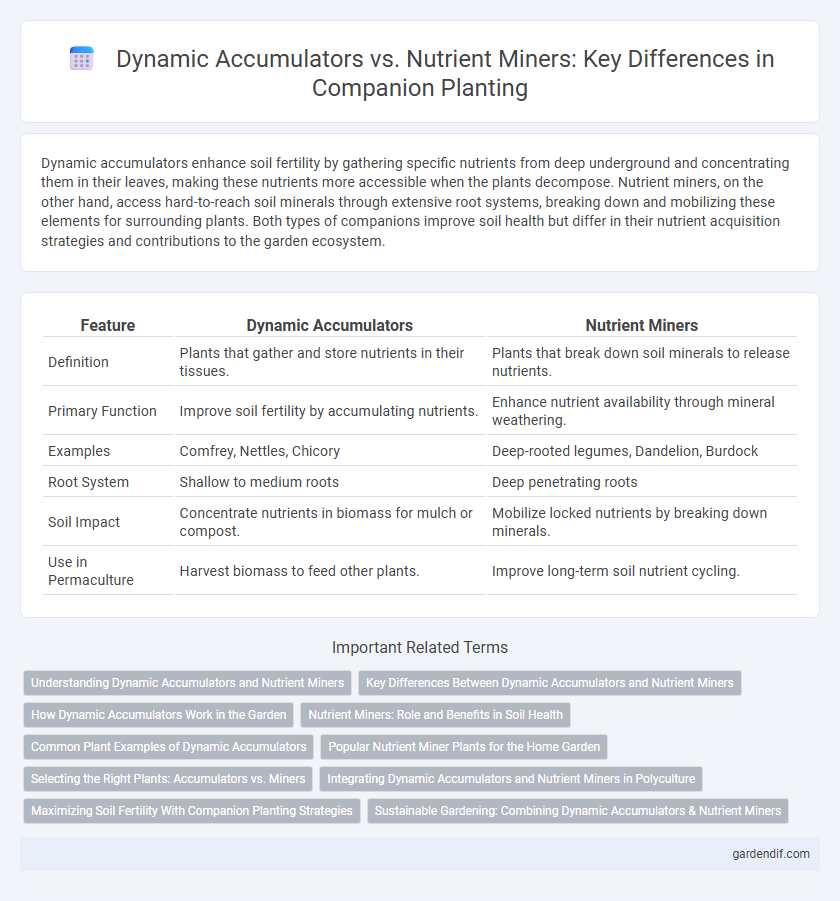
Dynamic accumulators vs nutrient miners Illustration
Dynamic accumulators enhance soil fertility by gathering specific nutrients from deep underground and concentrating them in their leaves, making these nutrients more accessible when the plants decompose. Nutrient miners, on the other hand, access hard-to-reach soil minerals through extensive root systems, breaking down and mobilizing these elements for surrounding plants. Both types of companions improve soil health but differ in their nutrient acquisition strategies and contributions to the garden ecosystem.
Table of Comparison
| Feature | Dynamic Accumulators | Nutrient Miners |
|---|---|---|
| Definition | Plants that gather and store nutrients in their tissues. | Plants that break down soil minerals to release nutrients. |
| Primary Function | Improve soil fertility by accumulating nutrients. | Enhance nutrient availability through mineral weathering. |
| Examples | Comfrey, Nettles, Chicory | Deep-rooted legumes, Dandelion, Burdock |
| Root System | Shallow to medium roots | Deep penetrating roots |
| Soil Impact | Concentrate nutrients in biomass for mulch or compost. | Mobilize locked nutrients by breaking down minerals. |
| Use in Permaculture | Harvest biomass to feed other plants. | Improve long-term soil nutrient cycling. |
Understanding Dynamic Accumulators and Nutrient Miners
Dynamic accumulators are plants that absorb and store specific nutrients from the soil, making these elements more accessible when the plant decomposes or is used as mulch. Nutrient miners, in contrast, dig deeper into the soil profile, accessing nutrients unavailable to shallow-rooted plants and bringing them to the surface where they can be utilized by other plants. Understanding the distinct roles of dynamic accumulators and nutrient miners enables optimized companion planting strategies for enhanced soil fertility and nutrient cycling.
Key Differences Between Dynamic Accumulators and Nutrient Miners
Dynamic accumulators selectively concentrate specific nutrients like phosphorus or potassium within their tissues, making these elements more bioavailable when the plants decompose. Nutrient miners, by contrast, break down complex soil minerals and organic matter to release a broader spectrum of nutrients such as nitrogen, calcium, and magnesium into the soil. The key difference lies in dynamic accumulators' targeted nutrient uptake versus nutrient miners' role in soil mineral weathering and nutrient mobilization for overall soil fertility enhancement.
How Dynamic Accumulators Work in the Garden
Dynamic accumulators function by extracting essential nutrients from deep soil layers through their extensive root systems, making these elements available in their leaves and organic matter. When their foliage decomposes, it releases concentrated minerals such as potassium, calcium, and magnesium back into the upper soil, enhancing fertility naturally. Gardeners strategically plant dynamic accumulators among crops to improve nutrient cycling and foster healthier plant growth without synthetic fertilizers.
Nutrient Miners: Role and Benefits in Soil Health
Nutrient miners play a crucial role in soil health by breaking down organic matter and releasing essential nutrients like nitrogen, phosphorus, and potassium, making them readily available for plant uptake. Their activity improves soil fertility and enhances microbial diversity, contributing to a balanced and sustainable ecosystem. By increasing nutrient cycling efficiency, nutrient miners support robust plant growth and long-term agricultural productivity.
Common Plant Examples of Dynamic Accumulators
Dynamic accumulators are plants that concentrate specific nutrients from the soil in their tissues, making them valuable for improving soil fertility when used as companion plants. Common examples include comfrey, which accumulates potassium and calcium, nettle rich in nitrogen, and dandelion known for extracting phosphorus and iron. These plants differ from nutrient miners, which primarily access deep soil minerals, by actively enriching the topsoil nutrients through their leaf litter and root exudates.
Popular Nutrient Miner Plants for the Home Garden
Popular nutrient miner plants for the home garden include comfrey, dandelion, and chicory, known for their deep roots that extract minerals from subsoil layers inaccessible to most plants. These plants enhance soil fertility by bringing vital nutrients like potassium, calcium, and phosphorus to the surface, enriching the topsoil for companion crops. Unlike dynamic accumulators that store nutrients in their foliage, nutrient miners primarily focus on mining essential minerals from deep layers, promoting sustainable garden nutrition.
Selecting the Right Plants: Accumulators vs. Miners
Selecting the right plants requires understanding the roles of dynamic accumulators versus nutrient miners in soil health. Dynamic accumulators like comfrey and nettle concentrate vital nutrients such as potassium, calcium, and magnesium from deep soil layers, making them available for nearby plants. Nutrient miners, meanwhile, improve soil structure and unlock bound nutrients by breaking down organic matter, enhancing overall fertility and plant growth.
Integrating Dynamic Accumulators and Nutrient Miners in Polyculture
Integrating dynamic accumulators and nutrient miners in polyculture enhances soil fertility by targeting diverse nutrient pools, with accumulators concentrating elements like potassium and calcium while nutrient miners mobilize phosphorus and micronutrients from deeper soil layers. This complementary nutrient cycling reduces reliance on synthetic fertilizers, promoting sustainable agriculture and resilient ecosystem functions. Optimized spatial arrangement and species selection maximize nutrient accessibility and plant health in polyculture systems.
Maximizing Soil Fertility With Companion Planting Strategies
Dynamic accumulators enhance soil fertility by drawing up essential nutrients like potassium, calcium, and magnesium from deep within the soil, making them accessible to surrounding plants. Nutrient miners break down organic matter and release vital nutrients such as nitrogen and phosphorus, improving soil structure and nutrient availability. Combining dynamic accumulators with nutrient miners in companion planting strategies optimizes nutrient cycling and promotes healthier, more productive soil ecosystems.
Sustainable Gardening: Combining Dynamic Accumulators & Nutrient Miners
Dynamic accumulators and nutrient miners enhance soil fertility by extracting and concentrating essential nutrients from deep soil layers, benefiting sustainable gardening through improved nutrient cycling and reduced fertilizer reliance. Integrating plants like comfrey or dandelion (dynamic accumulators) with nutrient-mining species such as chicory or deep-rooted legumes creates a synergistic effect that replenishes topsoil with vital minerals including potassium, calcium, and phosphorus. This combination supports resilient plant growth, fosters biodiversity, and promotes eco-friendly soil management practices in permaculture systems.
Dynamic accumulators vs nutrient miners Infographic

 gardendif.com
gardendif.com